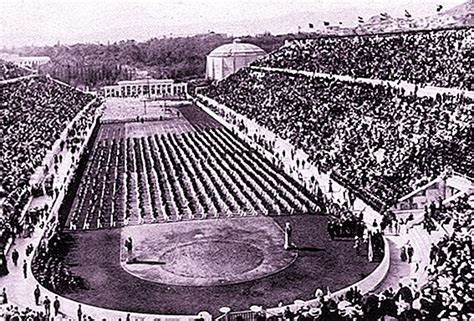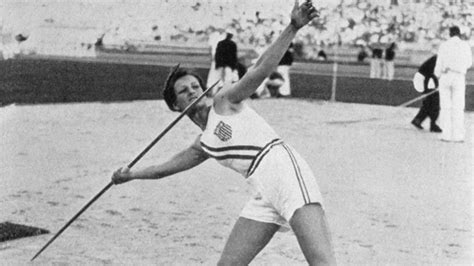Walt Murphy is one of the finest track statisticians that I know. Walt does #ThisDayinTrack&FieldHistory, an excellent daily service that provides true geek stories about our sport. You can check out the service for FREE with a free one-month trial subscription! (email: WaltMurphy44@gmail.com ) for the entire daily service. We will post a few historic moments each day, beginning February 1, 2024.
Track & Field History is copyrighted by Walt Murphy News and Results Services, and all rights are reserved. RunBlogRun uses this content with permission.
RelatedPosts
This Day in Track & Field-July 16
1894–10,000 spectators braved a wet and chilly day at the Queen’s Grounds at Kensington in London to watch Yale and Oxford face off in the first international collegiate meet.
1900—Another busy day at the Paris Olympics, with 8 finals being decided, five in events that had short stays on the Olympic schedule.
800—Great Britain’s Alfred Tysoe (2:01.2) outdueled American John Cregan (2:01.8) for the win. Tysoe would win a 2nd gold medal 6 days later in the 5k team race.
200-meter hurdles—Set back a yard for a false start(!), Al Kraenzlein still won easily in 25.4 to capture his 4th gold medal of the Games.
4000m-Steeplechase—In what is still the closest 3-person finish in an Olympic distance event (through 2021), Great
Britain’s John Rimmer (12:58.4) held off teammates Charles Bennett (12:58.6) and Sidney Robinson (12:58.8) to
win the gold. A day earlier, Bennett had won the gold medal in the 1500, while Robinson won silver in the 2500m
Steeplechase. It remains the only British medal sweep in track and field at the Olympics. (In a comparable finish at
the 1996 Olympics, only .41s separated the three medalists in the 5000-meters–Venuste Niyongabo-13:07.96,
Paul Bitok-13:08.16, Khalid Boulami-13:08.37).

Standing High Jump/Long Jump/Triple jump—American Ray Ewry was the master of the standing jumps and won all three events here. He set a World Best of 5-5 1/8? (1.655m) in the High Jump, edged Irving Baxter, the winner of the Pole Vault and the standard High Jump, in the Long Jump (10-6 ¼ to 10-3 ¾?), and set another World Best in the Triple Jump (34-8 ½). Ewry, who battled polio as a child, would win a total of 8 Olympic golds in the standing jumps (and another two at the 1906 “Intercalated” Games—see link below).
Triple Jump—A day after his controversial loss in the Long Jump, Meyer Prinstein won this event with a leap of 47-5 ¾ (14.47)
Hammer Throw—John Flanagan, a native of Ireland, led a U.S. 1-2-3 sweep, winning the first of his three gold medals in the event with a throw of 167-4 (51.01). Winning silver and bronze were Truxton Hare (151-9 [46.25]) and Josiah McCracken (146-0 [44.50]).
1915—Former Brown star Norm Taber, the bronze medalist in the 1500-meters at the 1912 Olympics, ran 4:12.6 for the
Mile at Harvard to break the World Record of 4:14.4, which had been set by John Paul Jones on the same track in 1913.
Taber’s mark would last for 8 years until Paavo Nurmi ran 4:10.4 in 1923. Taber won the first New England Intercollegiate
X-Country title in 1912.
https://browntrack.wordpress.com/2011/03/06/norm-taber-1913/
1932–Jack Keller tied the World Record of 14.4 in the 110-meter hurdles at the U.S. Men’s Olympic Trials at Stanford. It was the first world record with an official wind reading (-0.2).
Bill Miller and Bill Graber both cleared 14-1 5/8 (4.30) in the Pole Vault to better the existing World Record, while Graber went on to claim sole possession of the record with his clearance at 14-4 3/8 (4.37m). Miller had the last laugh, though, winning the gold medal less than a month later at the L.A. Olympics
Ralph Metcalfe won the 100 (10.6) and 200 (21.5) over Eddie Tolan (10.7, 21.7), with Tolan going on to win Olympic gold in both events.
Others who went on to win Olympic gold in L.A. were Bill Carr (400), Ed Gordon (Long Jump), Leo Sexton (Shot Put), John Anderson (Discus). Another gold medalist-to-be was decathlete Jim Bausch, who qualifed for the U.S. team in June
Fordham’s Joe McCluskey, who would win bronze in L.A., set an American Record of 9:14.5 in the Steeplechase.
Results/Notes: https://trackandfieldnews.com/wp-content/uploads/2019/10/1932.pdf
NY Times(For subscribers?): https://timesmachine.nytimes.com/timesmachine/1932/07/17/100835984.pdf?pdf_redirect=true&ip=0
WR Progressions:
110-Hurdles: http://en.wikipedia.org/wiki/Men%27s_110_metres_hurdles_world_record_progression
Pole Vault: http://en.wikipedia.org/wiki/Men’s_pole_vault_world_record_progression
Metcalfe: https://www.usatf.org/athlete-bios/ralph-metcalfe
Tolan: https://en.wikipedia.org/wiki/Eddie_Tolan
1932—19-year-old Mildred “Babe” Didrikson was the show’s star at the combined U.S. Women’s Olympic Trials and National Championships, held at Northwestern University in Evanston, Illinois (same weekend as the Men’s Trials).
Running from event to event, she was an outright winner in 5 events and tied for 1st in another. She qualified for the Olympic team in the 80-Meter Hurdles (12.1), the Javelin (139-3 [42.44], and the High Jump, where she shared the win with Jean Shiley as both cleared an American Record of 5-3 3/16 (1.60). She also won National Tiles in the Long Jump (17-6 1/8 [5.335]), Shot Put (39-6 ¼ [12.045]), and the Baseball Throw! (272-2 [82.96?]). She also finished 4th in the Discus. The only entry for the Employers Casualty Company Club of Dallas, she won the AAU team title by herself!
Didrikson would win gold medals in the hurdles and the Javelin at the L.A. Olympics but was beaten for the gold in the HJ by Shiley.
Others who went on to medal in L.A. were Lillian Copeland (gold) and Ruth Osburn (silver) in the Discus, and Evelyne Hall (Silver) in the 80-Meter Hurdles. Osburn set an American Record of 133-3/4 (40.55) at the Trials.
Bios
Didrikson: https://en.wikipedia.org/wiki/Babe_Didrikson_Zaharias
Also: https://www.olympedia.org/athletes/77808
Shiley(1993): https://www.usatf.org/athlete-bios/jean-shiley
Copeland(1994): https://www.usatf.org/athlete-bios/lillian-copeland
Results/Notes: https://trackandfieldnews.com/wp-content/uploads/2019/10/1932.pdf
NY Times(for subscribers?): https://timesmachine.nytimes.com/timesmachine/1932/07/17/100835983.pdf?pdf_redirect=true&ip=0
1960—Five American Records were set at the U.S. Women’s Olympic Trials in Abilene, Texas (July 15,16)—Wilma Rudolph in the 100 (=11.5/also won the 200), Billie Pat Daniels in the 800 (2:15.6), Willye White in the Long Jump (20-4 ½ [6.21m]), Earlene Brown in the Discus (176-10 [53.90]), also won the Shot Put), and Karen Anderson Oldham in the Javelin (163-5 ½ [49.82]).
Rudolph would attain legend status by winning 3 gold medals at the Rome Olympics (100, 200, 4×100). Brown won the bronze medal in the SP in Rome.
The Women’s 800 was contested at the Trials for the first time since 1928 when Olympic officials dropped the event after falsely concluding after the Games in Amsterdam that women couldn’t safely run that far! It would return to the Olympic program in Rome.
Four women who competed in the 800 at the Trials had successful careers in the sport.
16-year-old Daniels, later known as Pat Connolly, competed in the 5-event Pentathlon at the 1964 and 1968 Olympics and was the first women’s coach at UCLA (coached by Evelyn Ashford).
3rd-placer Doris Severtsen (17), better known now as Doris Brown Heritage, became a 5-time World X-Country Champion and member of the National Hall of Fame.
4th in the race was Louise Mead (Tricard), who chronicled the history of women’s T&F in the U.S. with her two books: American Women’s Track and Field : A History, 1895 Through 1980, followed by American Women’s Track and Field, 1981-2000 : A History
5th was Judy Shapiro (Ikenberry), who became the first U.S. Women’s Champion in the Marathon in 1974.
(Thanks to Amby Burfoot’s insightful look at the state of women’s running in the U.S. in 1960 and the young pioneers who paved the way for a better future.)
Results/Notes: https://trackandfieldnews.com/wp-content/uploads/2019/10/1960.pdf
Bios
Rudolph: https://www.usatf.org/athlete-bios/wilma-rudolph
White: https://en.wikipedia.org/wiki/Willye_White
E.Brown: https://www.usatf.org/athlete-bios/earlene-brown
D.Brown-Heritage: https://www.usatf.org/athlete-bios/doris-brown-heritage
Daniels-Connolly: https://en.wikipedia.org/wiki/Pat_Daniels
Other Links
Shapiro-Ikenberry: http://joehwritings.blogspot.com/2016/03/judy-ikenberry.html
Mead-Tricard: https://forum.trackandfieldnews.com/forum/historical/31380-louise-tricard-has-died
1961-Six World Records were set at the 3rd edition of the U.S.-Soviet Union dual meet, which was held over two days in Moscow (7-15/16). Attendance was about 60,000 on the first day, 70,000 on the second day!
The U.S. set new standards in both 4×100 relays on the first day of competition (7-15). Hayes Jones, Frank Budd, Charles Frazier, and Paul Drayton won the men’s race in 39.1 to break Germany’s World Record of 39.5, while Willye White, Ernestine Pollard, Vivian Brown, and the great Wilma Rudolph won the women’s race in 44.3. Rudolph also won the 100 (7-15) in the world-record tying time of 11.3 (mark never ratified by the IAAF).
Ralph Boston raised his own World Record in the Long Jump by two inches, jumping 27-2 (8.24) Finishing 2nd with a jump of
26-3 ½ (8.01) was Igor Ter-Ovanesyan, one of Boston’s biggest rivals.
Two Soviets accounted for the other two marks. Valery Brumel raised his World Record in the High Jump to 7-4 ¼ (2.24), with John Thomas finishing 2nd with a leap of 7-2 1/4 (2.19), and Tatyana Shchelkanova set a new standard in the Long Jump (21-3 ¼ [6.48]).
Additional American Records were set by Willye White in the Women’s Long Jump (21-0 [6.40]), George Young in the Steeplechase (8:38.0), and Cherrie Parrish and JoAnn Terry, both of whom ran 11.1 in the 80-meter hurdles.
Sports Illustrated Vault:
https://vault.si.com/vault/1961/07/24/the-high-meet-the-mighty
Rudolph Link
Book Excerpt: http://tinyurl.com/2957lvn
Story on the 1962 US-Soviet dual meet:
https://bleacherreport.com/articles/342578-usa-vs-ussr-1962-the-greatest-track-meet-of-all-time
WR Progressions:
Men’s 4×100: http://en.wikipedia.org/wiki/Men%27s_4_x_100_metres_relay_world_record_progression
Women’s 4×100: https://en.wikipedia.org/wiki/Women%27s_4_×_100_metres_relay_world_record_progression
High Jump http://en.wikipedia.org/wiki/Men’s_high_jump_world_record_progression
Men’s Long Jump http://en.wikipedia.org/wiki/Long_jump_world_record_progression
Women’s Long Jump http://en.wikipedia.org/wiki/Long_jump_world_record_progression
1961–Iolanda Balas set her 14th (and final) World Record in the High Jump with her clearance of 6-3 1/4 (1.91) in Sofia, Bulgaria.
IAAF Hall of Fame Bio: http://www.iaaf.org/athletes/hall-of-fame
WR Progression: http://en.wikipedia.org/wiki/Women’s_high_jump_world_record_progression
5-08 7/8 1.75 July 14, 1956
5-09 ¼ 1.76 October 13, 1957 (Tied Mildred McDaniel-USA/Dec.1, 1956)
5-10 1/8 1.78 June 7, 1958 (Zheng Fengrong-CHN 5-09 5/8 (1.77) Nov.17, 1957
5-10 7/8 1.80 June 22, 1958
5-11 ¼ 1.81 July 31, 1958
5-11 5/8 1.82 October 4, 1958
6-00 1.83 October 18, 1958
6-00 ½ 1.84 September 21, 1959
6-00 ¾ 1.85 June 6, 1960
6-01 ¼ 1.86 July 10, 1960
6-01 ½ 1.87 April 15, 1961
6-02 1.88 June 18, 1961
6-02 ¾ 1.90 July 8, 1961
6-03 ¼ 1.91 July 16, 1961
1967—Earl McCullouch, the recent NCAA Champion from USC, ran 13.2 (13.43-auto) at the Pan-American Games Trials in Minneapolis to equal the World Record in the 110-meter hurdles, which was shared by Germany’s Martin Lauer and American Lee Calhoun. McCullouch took as much pleasure at beating Willie Davenport (13.6) for the 1st time as he did for getting a share of the record.
Wiki Bio: http://en.wikipedia.org/wiki/Earl_McCullouch
1970—Kansas State’s Ken Swenson, winner of the 880y at the NCAA Championships the previous month, set an American Record of 1:44.8 for 800-meters in Stuttgart.
https://www.kshof.org/team/ken-swenson
https://www.youtube.com/watch?v=U8zYcpMosGI
1971—The Pan-Africa vs USA Dual meet, held at Duke’s Wallace Stadium in Durham, North Carolina, was a smashing success, drawing more than 50,000 spectators to the 2-day affair (16/18,000, 17/34,000).
The highlight of the first day of competition was the Men’s 5000-Meters, which featured a spirited duel between America’s best, Steve Prefontaine, against the unheralded Miruts Yifter of Ethiopia.
With less than 2 laps to go, Yifter went into overdrive, opening up a 40-yard gap on Pre. As he approached the beginning of the final lap, Yifter threw his arms up-in victory and stopped, thinking the race was over! He didn’t bother to resume running as Pre went by him, running the full distance and winning in 13:57.6.
Yifter returned the next day as a non-scoring entrant in the 10,000-Meters, and, with Pan-Africa coaches and officials making sure he was aware of the lap count, he won a close race over Frank Shorter (28:53.2-28:54.0).
While Yifter was virtually unknown before this weekend, he would go on to have a great career as one of the best distance runners in the world, capped by a double win in the 5000 and 10,000 at the 1980 Olympics in Moscow.
The meet, which was conducted in 90-degree weather both days, was put together by coaches Dr.Leroy Walker (North Carolina Central) and Al Buehler (Duke) and was supported by favorable local media.
https://today.duke.edu/2016/07/panafrica
https://vault.si.com/vault/1971/07/26/africa-was-right-on-in-dixie
https://fansided.com/2021/07/19/duke-pan-africa-usa-international-track-meet/























